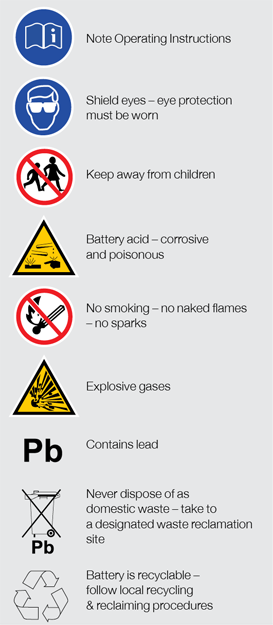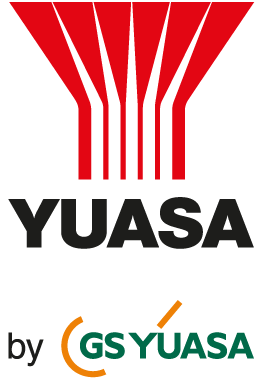Handling and the proper use of Lead Acid Batteries are not hazardous providing sensible precautions are observed, appropriate facilities are available and personnel have been given adequate training.
In accordance with the Consumer Protection Act 1987, the purpose of this guide is to :-
1. Indicate the main hazards which may arise
2. Outline the precautions to be taken to minimise such hazards
3. Indicate the emergency actions to be taken in the event of the occurrence of a hazard
A – Label Information
The following symbols are being used on all batteries and mean the following:

B – Battery Acid
The Hazard
Batteries contain Sulphuric Acid which may leak for various reasons. Also acid may be given off as droplets and/or spray/mist during recharge.
Sulphuric Acid is a corrosive and poisonous liquid which will cause burns and irritation to the skin and eyes and could severely damage clothing.
Refer to Health & Safety Executive Guidance Note EH40 for the latest occupational exposure limits for acid mist in air.
Precautions
- Always handle batteries with care
- Never overfill with acid
- Always store upright
- Never allow children access to a battery
- Always charge in a well ventilated area
- Never allow battery vents to become blocked
- Always wear eye protection
- Always wear protective clothing
Accident or Emergency Action and Treatment
Skin contact –
Immediately soak the affected area with copious amounts of clean water, remove any contaminated clothing and seek medical attention if irritation persists.
Eye contact –
Immediately irrigate eyes for at least 10 minutes with clean water, seek medical attention.
Ingestion –
Immediately drink as much water as possible – do NOT induce vomiting, seek urgent medical attention.
Spillages –
For small spillages wash away with large quantities of water. For larger volumes dispose of in suitable acid resistant containers, clearly labelled – see section H.
C – Electrical Energy
The Hazard
Accidental short circuit of battery terminals by a conductive object, such as a metal tool or item of jewellery etc. may generate sufficient heat to cause severe burns, create arcing or cause any metal to melt and splash.
Severe electrical shocks may be received from faulty mains electrical charging equipment and during the recharge of high voltage battery systems or the recharge of a number of batteries connected in series i.e. 5 or more 12V batteries in series = 60V nominal.
Precautions
Always remove metal objects from hands, wrists & neck e.g. rings, bracelets, watches & necklaces.
Always, when working on vehicle electrical systems, disconnect the battery, but before disconnection:
• Switch off all electrical loads
• Refer to vehicle manufacturer’s handbook
• Make the first disconnection and the last reconnection the earth point as far from the battery as possible
Always take great care to avoid shorting the live terminal to earth.
Never place tools or metal objects near to or on top of a battery.
Accident or Emergency Action and Treatment
Burns
Apply a dry sterile dressing and seek medical treatment.
Electric shock
Approach person with care. If the individual is clear of the conductor then, with caution, switch off equipment or break the current. If the individual is still attached to the conductor do not touch with bare hands. If possible use a suitable insulating material e.g. wood, rubber, plastic or rolled paper, to detach the conductor from the victim. If necessary, summon assistance then give artificial respiration until it arrives.
D – Emission of Gases
The Hazard
Hydrogen gas emitted during charging is explosive at concentration levels above 4%. Hydrogen & oxygen gases are both evolved during battery recharging. These gases may also be emitted at other times, for example, if the battery is moved or shaken.
Precautions
• Always charge in a well ventilated area
• Always ensure the charging leads are correctly fitted before switching on the mains
• Always ensure the mains is switched off before disconnecting the charging leads
• Always use eye protection and protective clothing
• Always wait at least 5 minutes after ceasing recharge before disconnection
• Always take care to ensure that cables and connections are handled in a way that avoids accidental sparking
Never smoke near a battery
Never allow naked flames near a battery
Never create sparks near a battery
Accident or Emergency Action ?and Treatment
Seek medical advice as appropriate to injury.
In an explosion acid will have been sprayed and ejected and plastic & metal parts may have caused severe lacerations.
E – Jump Starting
The Hazard
Use of an incorrect procedure when “jump starting” a vehicle could result in a battery explosion, fire and burns to the individual as well as damage to the vehicle electrical system.
Precautions
Always follow the correct procedure as defined in the vehicle manufacturers handbook.
In the absence of this information, for a negatively earthed vehicle :-
- Make sure the vehicles are not touching and that the ignition in both vehicles is turned off. Ensure both vehicles are in neutral or “park”.
- Connect the positive (red) cable from positive terminal on one vehicle battery to positive terminal on the other vehicle battery.
- Connect the negative (black) cable to the negative terminal of the vehicle with the “flat” battery – keeping clear from fuel lines and brake pipes.
- Connect the negative cable to the negative terminal of the current supplying vehicle, or to an earthed point on the vehicle away from the battery e.g. engine casing.
- Ensure all connections are tight and away from moving or rotating components.
- Start the engine of the vehicle with the “good” battery and allow to run for one minute.
- Start the engine of the vehicle with the “flat” battery and allow to run for at least one minute.
- Stop the engine of the vehicle with the “good” battery.
- Remove the cables in the opposite order keeping them well away from any moving or rotating components on the vehicle.
Accident or Emergency Action ?and Treatment
Seek medical advice as appropriate to the injury.
F – Weight
The Hazard
Batteries are awkward and heavy to handle resulting in possible strains to the human body as well as potential for dropping the battery, with resultant acid spillage, injury etc.
Precautions
Always use correct lifting procedures to minimise strain to the human body.
Always use lifting handle or lifting ledges if available on the battery.
Accident or Emergency Action ?and Treatment
Seek medical advice as appropriate to the injury. Remember that acid may have been spilled.
G – Repairing of Damaged Batteries
No attempt should ever be made to renovate or repair a ?damaged battery.
This work involves all of the hazards detailed in sections A to F above and should only be carried out by suitably trained personnel with appropriate facilities and in accordance with the manufacturer’s instructions.
H – Disposal of Batteries & Associated Waste
All spent batteries and waste arising from spillages and fires must be disposed of in conformance with the Environmental Protection Act, the Special Waste Regulations 1996 and the Environmental Protection (Duty of Care) Regulations 1991.
Yuasa offer a complete battery disposal service.
For further information please contact us at:
Tel: +44 (0) 1793 833555
Email: enquiries@yuasaeurope.com
I – Fire
Since batteries contain combustible materials, the local Fire Authority should be consulted where a quantity of batteries are stored together.
J – Safety Data Sheet
More detailed Health & Safety information is available MATERIAL?SAFETY DATA – Batteries, Wet, Filled with Acid, on
page 393 – 394.
K – REACH Regulation (EC) No 1907/2006
Registration, Evaluation, Authorisation and Restriction ?of Chemicals
Industry is required by REACH to evaluate and manage the ?risks posed by chemicals, and to provide safety information to product users.
Information on up-to-date additions to the Substances of Very High Concern (SVHC) Candidate List is available from the ECHA (European Chemicals Agency) web site: www.echa.europa.eu
Yuasa’s compliance information is available on request. ?Enquiries should be directed to:
• Tel: +44 (0) 1793 833555
• Email: enquiries@yuasaeurope.com



